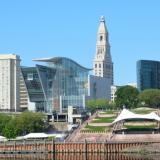Coltsville
The First Congressional District will soon be home to Connecticut's first national historical park: the Coltsville National Historical Park.
Driving into Connecticut's Capitol City you will undoubtedly notice the bright blue and white, onion shaped dome on the side of I-91. This well-known local architecture marks an area known as Coltsville, where Colt's Patent Firearms Manufacturing Company once thrived. Coltsville includes Colt Park, the former home of Samuel and Elizabeth Colt, housing used by factory workers, armories where firearms and other products were manufactured, and more.
Beginning in 1855, Sam and Elizabeth Colt created a community around manufacturing in Hartford, widely recognized as one of the birthplaces of the industrial revolution. Following the death of her husband, Elizabeth Colt became the first woman to lead a top five manufacturing company, was one of the first industrialists to implement firewalls, and developed an apprenticeship program that spawned the typewriter, the automobile, and ultimately the airplane engine.
Timeline of Congressman Larson's Efforts on Coltsville
In Washington, Representative Larson is leading the effort to authorize the establishment of Coltsville as a National Historical Park. In 2014, President Obama signed Representative Larson's Coltsville National Historical Park Act into law, as part of the 2014 National Defense Authorization Act (P.L.113-291). Since then, stakeholders including Rep. Larson, the City of Hartford, the National Park Service and current building and land owners are working together to complete the transfer of property to the federal government. When this final step is completed, Coltsville will formally be established as a National Historic Park.
Earlier this year, Congressman Larson secured $1 million for the Colt Gardner’s Cottage and Colt Carriage House. Restoring these historic buildings will preserve more Coltsville history and allow them to be available for public use and enjoyment.
The establishment of Coltsville as a National Historical Park fulfills a long-term goal envisioned by Hartford Mayor Mike Peters and shared by the Sheldon/Charter Oak neighborhood, the city, the state and countless community stakeholders. Coltsville not only preserves a crucial piece of Connecticut history, it also benefits the local and regional economy through economic development, tourism and job creation. Studies by the National Park Service point to over $12 billion dollars spent annually with more than 177,000 jobs created in regions surrounding National Parks. The Connecticut Economic Resource Center estimates that development at Coltsville already accounts for more than 1,000 jobs and an economic impact of over $177 million with the potential for 2,500 jobs and an economic impact of over $350 million as a result of tourism and continued development bolstered by park establishment.
More information about Coltsville National Historical Park can be found here.




